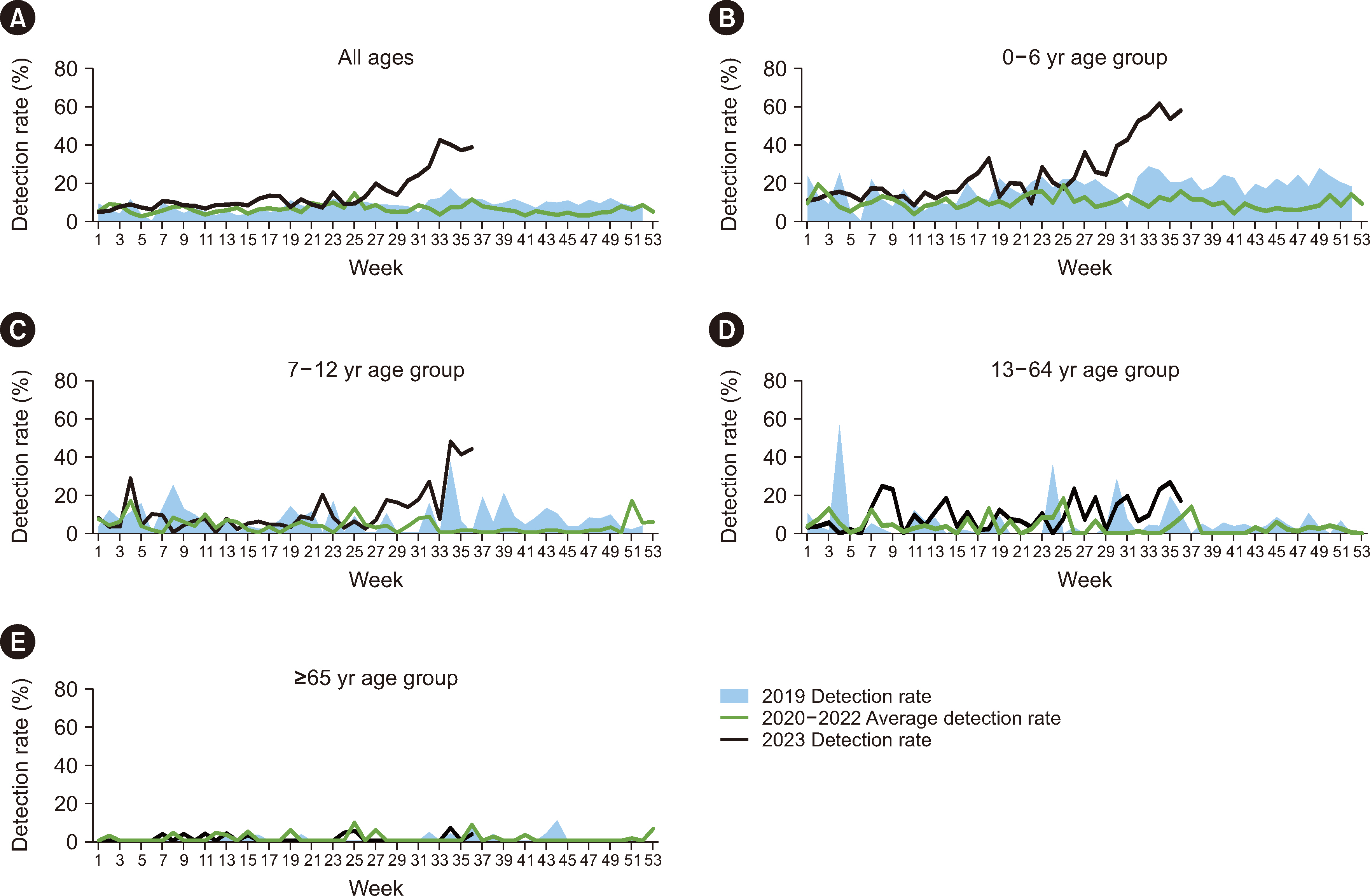Ann Lab Med.
2024 Nov;44(6):581-585. 10.3343/alm.2023.0484.
Increased Trend of Adenovirus Activity After the COVID-19 Pandemic in South Korea: Analysis of National Surveillance Data
- Affiliations
-
- 1Division of Emerging Infectious Diseases, Department of Laboratory Diagnosis and Analysis, Korea Disease Control and Prevention Agency (KDCA), Cheongju, Korea
- 2Department of Laboratory Diagnosis and Analysis, Korea Disease Control and Prevention Agency (KDCA), Cheongju, Korea
- KMID: 2560806
- DOI: http://doi.org/10.3343/alm.2023.0484
Abstract
- The adenovirus detection rate is < 10% throughout the year in South Korea; however, during the summer of 2023, it showed an unusual increase. We analyzed the adenovirus detection rate using data from the Korea Respiratory Integrated Surveillance System before and after coronavirus disease (COVID-19) collected from 2019 to week 36 of 2023. Before the COVID-19 outbreak in 2019, the mean detection rate was 8.2%, which decreased to 6.1% during the COVID-19 pandemic from 2020 to 2022. In 2023, the mean detection rate was 14.3% in week 36 and the highest in week 34, at 42.2%, and adenovirus was predominantly detected in the summer. The detection rate by age group showed substantially high activity among 0–12-yr-olds after the pandemic. This age group had a steady mean rate of 9.5% during the pandemic, without seasonality. In 2023, the detection rate surged in the 0–6-yr and 7–12-yr age groups, peaking at 61.6% and 57.1%, respectively. The dominant epidemic serotypes were HAdV-1 and HAdV-2 during and HAdV-3 after the pandemic. The multifaceted non-pharmaceutical interventions during the COVID-19 pandemic considerably impacted the prevalence of common respiratory viruses and complicated respiratory virus patterns after the pandemic. Constant surveillance is crucial for epidemic preparedness to monitor the possible surge of certain respiratory viruses.
Keyword
Figure
Reference
-
References
1. HAdV Working Group. http://hadvwg.gmu.edu. Updated on Mar 2024.2. Loeb M, Kuchar E. Human Adenovirus Infections. https://empendium.com/mcmtextbook/chapter/B31.II.18.1.16. Updated on June, 2024.3. Kim IH, Kang SG, Cha JO, Seo YJ, Kwak J, Lee NJ, et al. 2023; Changes in patterns of respiratory virus since the coronavirus disease 2019 pandemic (until April 2023). Public Health Wkly Rep. 16:626–31.4. Lee WJ, Jung HD, Cheong HM, Kim K. 2015; Molecular epidemiology of a post-influenza pandemic outbreak of acute respiratory infections in Korea caused by human adenovirus type 3. J Med Virol. 87:10–7. DOI: 10.1002/jmv.23984. PMID: 24889391. PMCID: PMC7167096.5. Duan Y, Xu B, Li C, Bao Y, An S, Zhou Y, et al. 2021; Molecular characteristics of human adenovirus type 3 circulating in parts of China during 2014-2018. Front Microbiol. 12:688661. DOI: 10.3389/fmicb.2021.688661. PMID: 34267738. PMCID: PMC8276179. PMID: da6578faa7cb4cfaa1ad2dc92fee14cc.6. Lai CY, Lee CJ, Lu CY, Lee PI, Shao PL, Wu ET, et al. 2013; Adenovirus serotype 3 and 7 infection with acute respiratory failure in children in Taiwan, 2010-2011. PLoS One. 8:e53614. DOI: 10.1371/journal.pone.0053614. PMID: 23326469. PMCID: PMC3542335. PMID: 19264ac8561749119906a0d88c231feb.7. Wo Y, Lu QB, Huang DD, Li XK, Guo CT, Wang HY, et al. 2015; Epidemical features of HAdV-3 and HAdV-7 in pediatric pneumonia in Chongqing, China. Arch Virol. 160:633–8. DOI: 10.1007/s00705-014-2308-8. PMID: 25504360. PMCID: PMC7087000.8. Ujiie M, Tsuzuki S, Nakamoto T, Iwamoto N. 2021; Resurgence of respiratory syncytial virus infections during COVID-19 pandemic, Tokyo, Japan. Emerg Infect Dis. 27:2969–70. DOI: 10.3201/eid2711.211565. PMID: 34388086. PMCID: PMC8544984. PMID: dfc60d5d1b534de680ff26a2f12a56e3.9. Ben Moussa M, Buckrell S, Rahal A, Schmidt K, Lee L, Bastien N, et al. 2023; National influenza mid-season report, 2022-2023: a rapid and early epidemic onset. Can Commun Dis Rep. 49:10–4. DOI: 10.14745/ccdr.v49i01a03. PMID: 36815865. PMCID: PMC9902033.10. Chow EJ, Uyeki TM, Chu HY. 2023; The effects of the COVID-19 pandemic on community respiratory virus activity. Nat Rev Microbiol. 21:195–210. DOI: 10.1038/s41579-022-00807-9. PMID: 36253478. PMCID: PMC9574826.11. Tesema L, Sullivan D, Pulido M, Traub E, Escobar J, Moore L, et al. 2022; Notes from the field: influenza A(H3N2) outbreak following a school event - Los Angeles, California, March 2022. MMWR Morb Mortal Wkly Rep. 71:745–6. DOI: 10.15585/mmwr.mm7122a4. PMID: 35653298. PMCID: PMC9169524.12. Lee NJ, Woo SH, Lee JH, Rhee JE, Kim EJ. 2023; 2021-2022 influenza and respiratory viruses laboratory surveillance report in the Republic of Korea. Public Health Wkly Rep. 16:53–65.13. Lin MR, Yang SL, Gong YN, Kuo CC, Chiu CH, Chen CJ, et al. 2017; Clinical and molecular features of adenovirus type 2, 3, and 7 infections in children in an outbreak in Taiwan, 2011. Clin Microbiol Infect. 23:110–6. DOI: 10.1016/j.cmi.2016.11.004. PMID: 27851998. PMCID: PMC7129580.14. James L, Vernon MO, Jones RC, Stewart A, Lu X, Zollar LM, et al. 2007; Outbreak of human adenovirus type 3 infection in a pediatric long-term care facility-Illinois, 2005. Clin Infect Dis. 45:416–20. DOI: 10.1086/519938. PMID: 17638187.15. Adhikary AK. 2017; Genomic diversity of human adenovirus type 3 isolated in Fukui, Japan over a 24-year period. J Med Microbiol. 66:1616–22. DOI: 10.1099/jmm.0.000625. PMID: 29068283.16. Choi EH, Kim HS, Park KH, Lee HJ. 2006; Genetic Heterogeneity of the hexon gene of adenovirus type 3 over a 9-year period in Korea. J Med Virol. 78:379–83. DOI: 10.1002/jmv.20550. PMID: 16419117.
- Full Text Links
- Actions
-
Cited
- CITED
-
- Close
- Share
- Similar articles
-
- The Trend of Psychiatric Visits and Psychiatric Medication Prescription Among People Tested for SARS-CoV-2 During the Initial Phase of COVID-19 Pandemic in South Korea
- Changes in the prevalence of metabolic syndrome in Korean adults after the COVID-19 outbreak
- The COVID-19 pandemic's impact on prostate cancer screening and diagnosis in Korea
- Neglecting the neglected during the COVID-19 pandemic: the case of leptospirosis in Sri Lanka
- Changes in frequency of benign convulsions with mild gastroenteritis and their viral causes before and during the COVID-19 pandemic: a single-center study



